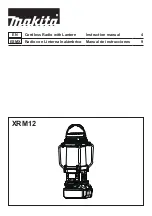
CIRCUIT DESCRIPTION
1) Receiver System
The receiver system is a double superheterodyne system with a 45.1 M H z first IF and a 455kH z second IF.
-4
r
»
J
i . r r u n i c n u
The received signal at any frequency in the 4 3 0 .0 0 - to 4 4 9 .9 9 5 -M H z range is
passed through the low-pass filter (L2, L3, L8, C2, C9, C 1 0, C 1 1, and C 62)
and high-pass filter (C 56, C 57, C 6 1 , L25 and D 25), and amplified by the RF
amplifier (Q 9). The signal from Q 9 is then passed through the tuning circuit
(L19, L20, L21 and varicaps D12, D 13 and D 14) and converted into 4 5 .1 M H z
by the mixer (Q 1 0). The tuning circuit, which consists of L25, L19, L20, L 2 1 ,
D 15, D 12, D 13 and D 14 is controlled by the tracking voltage form the C P U so
that it is optimized for the reception frequency. T h e local signal from the V C O
is passed through the buffer (Q11), and supplied to the source of the mixer
(Q 10). The radio uses the lower side of the superheterodyne system.
2. IF Circuit
The mixer mixes the received signal with the local signal to obtain the sum of
and difference betw een them. The crystal filter (X F 1 ) selects 4 5 .1 M H z fre
quency from the results and eliminates the signals of the unwanted frequen
cies. T h e first IF amplifier (Q 8) then amplifies the signal of the selected fre
quency.
3. Demodulator Circuit
After the signal is amplified by the first IF amplifier (Q 8), it is input to pin 16 of
the dem odulator IC (IC 4). The second local signal of 4 5 .5 5 5 M H z , which is
oscillated by the internal oscillation circuit in IC4 and crystal (X2). Then, these
two signals are mixed by the internal mixer in IC4 and the result is converted
into the second IF signal with a frequency of 455 kH z. T h e second IF signal is
output from pin 3 of IC4 to the ceram ic filter (F L 1 ), where the unwanted fre
quency band of that signal is eliminated, and the resulting signal is sent back
to the IC4 through pin 5.
T h e second IF signal input via pin 5 is dem odulated by the internal limiter
amplifier and quadrature detection circuit in IC4, and output as an audio signal
through pin 10.
4. Audio Circuit
T h e audio signal from pin 10 of IC4 is com pensated to the audio frequency
characteristics in the de-em phasis circuit (R 106, R 107, C 128, C 12 7) and a m
plified by the A F amplifier (Q 27). T h e signal is then input to pin 2 of the elec
tronic volum e (IC 6) for volum e adjustm ent, and output from pin 1. T h e a d
justed signal is sent to the audio power amplifier (IC 5) through pin 2 to drive
the speaker.
3
Содержание DJ-438
Страница 10: ...3 M5222FP 600C XA0385 Electronic Volume n ...
Страница 15: ...EXPLODED VIEW 1 Front View KZ0108 DJ 493 KZ0098 DJ 496 DJ 493 only 15 ...
Страница 16: ...2 R e r V i e w S t0063 ...
Страница 35: ...PC BOARD VIEW DJ 493 DJ 496 MAIN SIDE A D2 1 iO O 0 0 nm to L_ ...
Страница 37: ...SCHEMATIC DIAGRAM DJ 493 ...
Страница 39: ...BLOCK DIAGRAM DJ 493 39 LiVE 7RANSM T ...




































